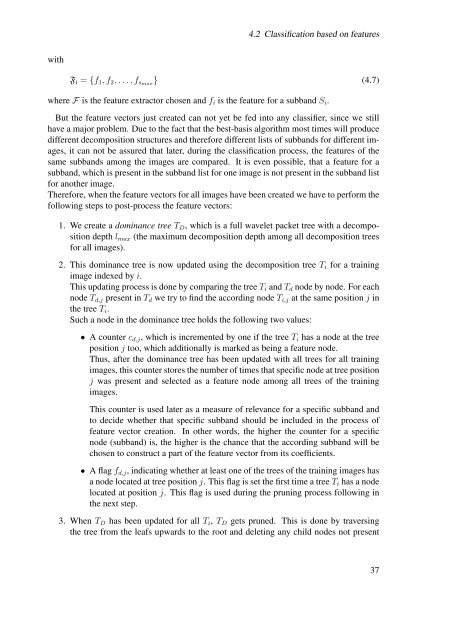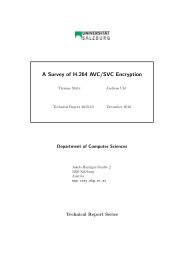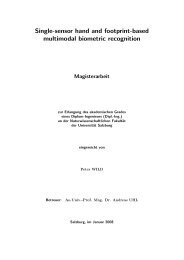Pit Pattern Classification in Colonoscopy using Wavelets - WaveLab
Pit Pattern Classification in Colonoscopy using Wavelets - WaveLab
Pit Pattern Classification in Colonoscopy using Wavelets - WaveLab
You also want an ePaper? Increase the reach of your titles
YUMPU automatically turns print PDFs into web optimized ePapers that Google loves.
4.2 <strong>Classification</strong> based on features<br />
with<br />
F i = {f 1 , f 2 , . . . , f smax } (4.7)<br />
where F is the feature extractor chosen and f i is the feature for a subband S i .<br />
But the feature vectors just created can not yet be fed <strong>in</strong>to any classifier, s<strong>in</strong>ce we still<br />
have a major problem. Due to the fact that the best-basis algorithm most times will produce<br />
different decomposition structures and therefore different lists of subbands for different images,<br />
it can not be assured that later, dur<strong>in</strong>g the classification process, the features of the<br />
same subbands among the images are compared. It is even possible, that a feature for a<br />
subband, which is present <strong>in</strong> the subband list for one image is not present <strong>in</strong> the subband list<br />
for another image.<br />
Therefore, when the feature vectors for all images have been created we have to perform the<br />
follow<strong>in</strong>g steps to post-process the feature vectors:<br />
1. We create a dom<strong>in</strong>ance tree T D , which is a full wavelet packet tree with a decomposition<br />
depth l max (the maximum decomposition depth among all decomposition trees<br />
for all images).<br />
2. This dom<strong>in</strong>ance tree is now updated us<strong>in</strong>g the decomposition tree T i for a tra<strong>in</strong><strong>in</strong>g<br />
image <strong>in</strong>dexed by i.<br />
This updat<strong>in</strong>g process is done by compar<strong>in</strong>g the tree T i and T d node by node. For each<br />
node T d,j present <strong>in</strong> T d we try to f<strong>in</strong>d the accord<strong>in</strong>g node T i,j at the same position j <strong>in</strong><br />
the tree T i .<br />
Such a node <strong>in</strong> the dom<strong>in</strong>ance tree holds the follow<strong>in</strong>g two values:<br />
• A counter c d,j , which is <strong>in</strong>cremented by one if the tree T i has a node at the tree<br />
position j too, which additionally is marked as be<strong>in</strong>g a feature node.<br />
Thus, after the dom<strong>in</strong>ance tree has been updated with all trees for all tra<strong>in</strong><strong>in</strong>g<br />
images, this counter stores the number of times that specific node at tree position<br />
j was present and selected as a feature node among all trees of the tra<strong>in</strong><strong>in</strong>g<br />
images.<br />
This counter is used later as a measure of relevance for a specific subband and<br />
to decide whether that specific subband should be <strong>in</strong>cluded <strong>in</strong> the process of<br />
feature vector creation. In other words, the higher the counter for a specific<br />
node (subband) is, the higher is the chance that the accord<strong>in</strong>g subband will be<br />
chosen to construct a part of the feature vector from its coefficients.<br />
• A flag f d,j , <strong>in</strong>dicat<strong>in</strong>g whether at least one of the trees of the tra<strong>in</strong><strong>in</strong>g images has<br />
a node located at tree position j. This flag is set the first time a tree T i has a node<br />
located at position j. This flag is used dur<strong>in</strong>g the prun<strong>in</strong>g process follow<strong>in</strong>g <strong>in</strong><br />
the next step.<br />
3. When T D has been updated for all T i , T D gets pruned. This is done by travers<strong>in</strong>g<br />
the tree from the leafs upwards to the root and delet<strong>in</strong>g any child nodes not present<br />
37








